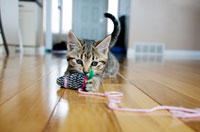How to Play With Your Cat- Part Two
 In Part One, we learned why play is important for cats and how to keep play time fun and safe. In Part 2, we present some hints on becoming a cat play expert—with one cat or several at a time, if you have the good fortune of living in a multiple feline household.
In Part One, we learned why play is important for cats and how to keep play time fun and safe. In Part 2, we present some hints on becoming a cat play expert—with one cat or several at a time, if you have the good fortune of living in a multiple feline household.
Techniques for Enhancing the Play Experience for your Cat
The following are general tips for playing. As we all know, there’s no “average” cat. Use this list as a starting point, but gauge your cat’s interest and preferences during play, so that over time you individualize your playing techniques to match your cat’s unique style.
- Small, incremental movements by the toy, such as a tentative step around the corner or the twitching of a whisker or tail, may compel kitty to lock onto the target and go into pre-pounce mode; once you see this, toss the toy along the floor so it flees from the kitty, who will be motivated to run after the escapee and apprehend it.
- Give your cat time to analyze. If the toy lands on the couch and the kitty is staring at it intently, he may be planning a surprise attack. Leave the toy in place long enough for him to execute his move. A start-and-stop pattern for the toy typically elicits more kitty involvement than constant movement does.
- Some coyness on the part of the toy usually heightens interest. For example, have the toy hide in a box or bag with just a bit of its tail sticking out.
- As the play session ends—with or without the final victory pounce—let the toy lose steam and “die.” Then you can carry off the defeated prey until it springs back to life and reappears in a week or so.
- Use sound to engage kitty’s ears as well as eyes in the hunt.
- Rub a throw toy along the carpet or floor, or with the edge of your fingernail a few times to create a “scritch, scritch” noise. Once you’ve piqued your kitty’s interest, give the toy a good shove and watch your little speedster catch it.
- Remove the semi-hard “sealed for your protection” plastic from a bottle of salad dressing, place it on the floor, crumple it up, and flick it with your finger. It will probably travel in an arc to the next room. When it comes to rest, it will slowly unfurl and make crackling sounds, which are sure to attract any nearby felines.
- Try dimming the lights. Since cats like to hunt in low-light situations where they have a greater advantage, a darkened room may get your kitty in the mood for stalking some catnip mice.
What if Kitty Wants to Play and You’re Not Available?
Before you go to sleep or leave for work, put a few cat-safe toys in locations that are not too obvious but not too hard for your feline sleuth to find. Balls or toy mice infused with catnip or sprayed with honeysuckle work well for this; the catnip or honeysuckle helps hold the kitty’s interest, and the toys are light enough to slide across the floor when kitty gives them a solid whack.
You can also buy a toy that releases kibble when a playful paw bats it around; leave it in a spot where your kitty will find it after a little searching.
As a result of your efforts, your cat will appreciate the amusement while you get to spend some time on pursuits that are not directly cat-related.
Interactive Play with Multiple Cats
You can multiply the fun, and the challenges, of interactive play if you have more than one feline participant. The goal is for all the cats to have a good time during group play sessions.
Typically, some cats in the group are alphas, or quicker than the rest, and will dominate the play opportunities unless you make sure the slower and less gregarious cats get their fair share of playing time. To accomplish this:
- Scatter throw toys in different directions to avoid cats having to compete with each other when chasing a single target.
- Distract the most dominant cat by throwing a toy into a challenging place. Then entertain the more laid-back cats with a wand toy.
- Improve your dexterity by handling two wand toys at once, pointing in opposite directions.
- If the more assertive cats are snoozing and some of the more timid cats are up and about, you can engage in some gentle play with the latter group. Do this in a separate room—let sleeping cats lie.
- Enlist the help of other humans in the vicinity. Why not get everyone in the family involved with kitty play times and make it a party?
- If need be, if Cat A always crowds out Cat B during playtime, you can bring Cat B to a private room, where he can enjoy an exclusive play session.
- Some cats, especially younger ones, play with each other. They chase and tussle like only cats can. All other things being equal, when interactively playing with your feline family members, you may want to give preference to the cats who don’t have a cat play buddy—but keep in mind that all the cats can benefit from your involvement; only you, the human, can set up scenarios that allow the cats to fully engage their hunting skills.
You May Also Like These Articles:
How to Play With Your Cat- Part One
The Dangers of Strings, Ribbons, and Yarn for Cats
Cat Weight Loss: How You Can Help Your Cat Lose Weight
What Does Catnip Do to Cats? Why Do Cats Like Catnip?
Honeysuckle: An Alternative to Catnip
Notice: Ask-a-Vet is an affiliated service for those who wish to speak with a veterinary professional about their pet's specific condition. Initially, a bot will ask questions to determine the general nature of your concern. Then, you will be transferred to a human. There is a charge for the service if you choose to connect to a veterinarian. Ask-a-Vet is not manned by the staff or owners of CatHealth.com, and the advice given should not delay or replace a visit to your veterinarian.




